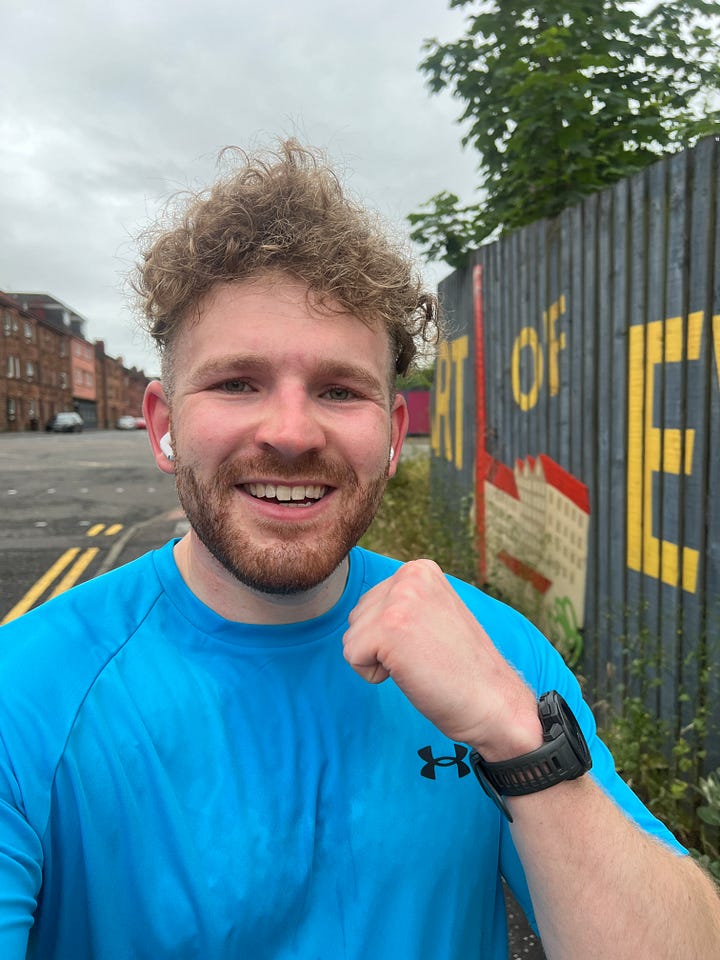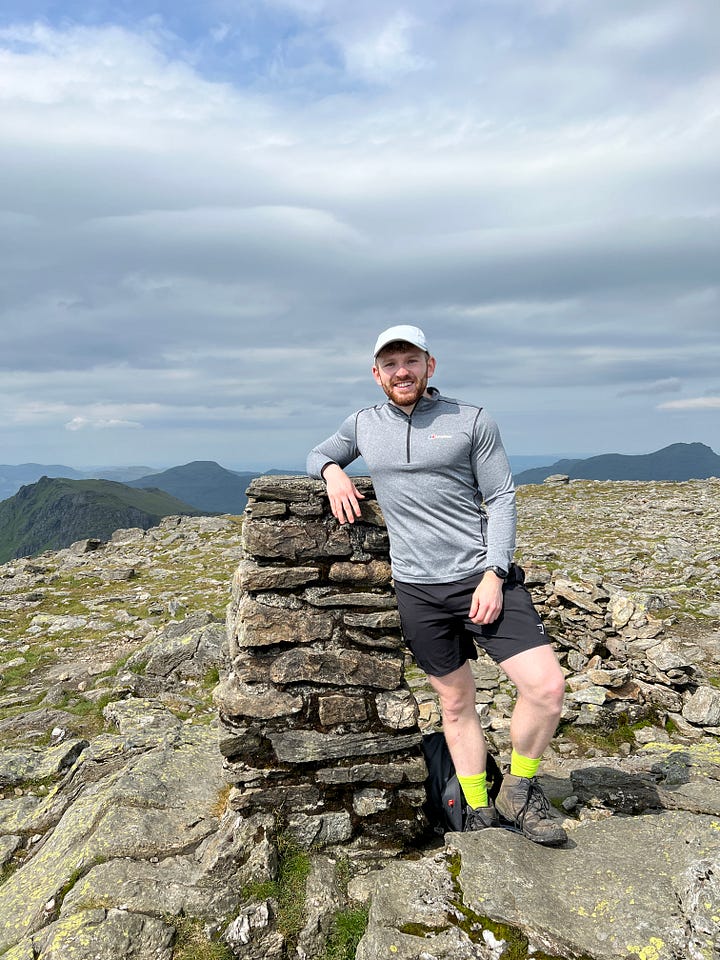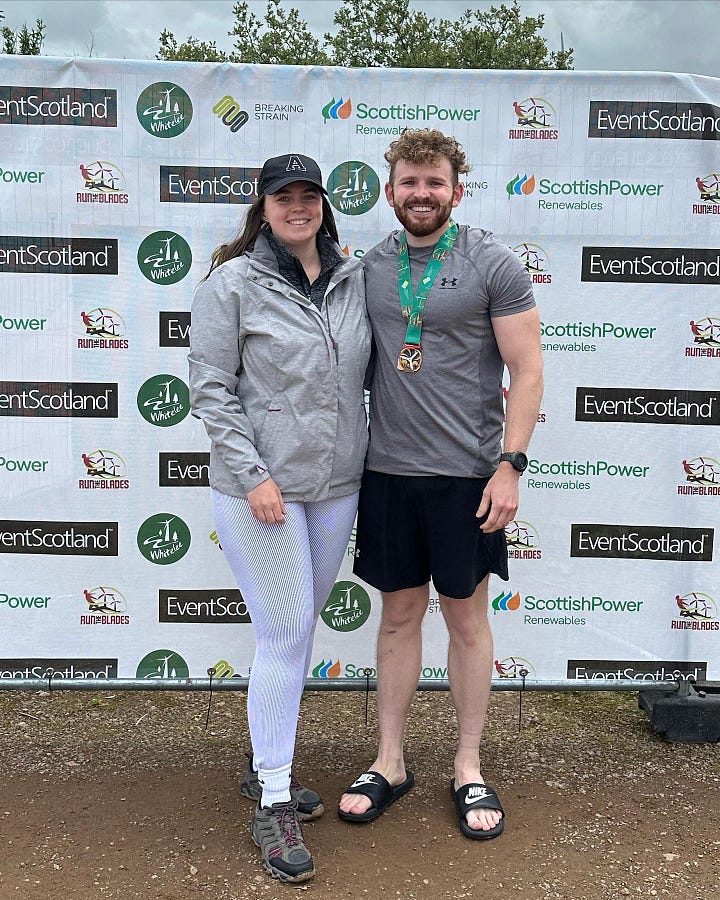I came back from a 2-week holiday feeling rejuvenated after an intense first 5 months of the year. Having pushed myself hard, my body and mind needed time away to recharge.
Sitting on the couch 24 hours after travelling across the Atlantic, I decided to look at any upcoming events I was interested in.
One caught my eye — Run The Blades 50k. The challenge was it was 3 weeks from the race.
Would my body and mind be ready for another hard race? There was only one way to find out.
I signed up.
How I Trained For The 3 Grueling Weeks
3 weeks isn’t an ideal time to peak for an endurance event.
If I had a full 8–12 weeks, I would’ve increased training distance each week, starting at 21km up to about 35–40km for my long slow runs.
3 weight sessions are a staple for any running event I do — part of being a hybrid athlete.
The training plan for those 3 weeks was as follows.
1. Upper Body and Conditioning
- Machine chest press
- Pull-up
- Seated row super-setted with standing dumbbell press
- Cable lateral raise super-setted with hammer curls
- 10x1 min hard pace → 1 min easy pace run
2. Lower Body
- Leg Press
- Dumbbell split squat & seated leg curl
- Hip extension & walking lunges
- Calf raises
3. Tempo Run
- 4x1km at zone 4 heart rate > 3 mins @ zone 1/2 (easy pace)
4. Upper Body
- Seated dumbbell shoulder press
- Bench press supersetted with single arm dumbbell row
- Close grip pull down, dumbbell floor press & rope tricep extension
5. Distance Builder Run (or Hike)
The challenge was to get myself as conditioned as possible.
Firstly, I had to get some distance under my belt. I hadn’t run more than 12 km since the beginning of May.
2 weeks before the race, I set out to run 25km up and across the trails.

Being July in Scotland, the weather turned when I summited the first big climb. It was torrential rain, not helped by the wind, which meant the rain was slapping me across the face.
The ground became more like wet, slippery grass than a trail. Coming down from a steep slope, I landed awkwardly and jarred my knee.
I yelped in pain.
I knew it wasn’t serious because I could walk fine. It gave me a scare and I continued running.
About 5 minutes had passed when I slipped on a rock, falling onto the side of my thigh. I was used to slipping and falling on difficult terrain, but this was different. My other knee and shin took a hit as well.
I stood up, looked down, and saw blood running down my leg.
Shit.
Instinctively, I took my pack off to get my First Aid kit out. It wasn’t there — I had left it in the car at the bottom of the hill.
I checked my phone. NO service.
I had a choice to make.
- Continue — I had 15km left.
- Turn back and tidy up the nasty-looking cut.
I chose the latter but I didn’t want to do further damage or get the wound infected.
What Did This Teach Me?
Honestly, this decision sat with me for a few days. I knew my body was capable of doing that extra 15km. But I had to make sure I cleaned my cut. My confidence was dashed.
Part of me wishes I continued. Part of me worried I wasn’t going to be ready.
I’m an optimistic person, which meant focusing on the fact I knew I had the distance in me was what I chose to focus on.
1 Week To Go
The week before the ultra, I had a hill walk planned to summit 2 Munro mountains near Loch Lomond.
This allowed me to accumulate a good amount of elevation and prepared me for the inevitable climbs on race day.
In the week leading up to the mountain climb, I focussed on getting 8 hours of sleep each night, 1g of protein per lb of body weight, and plenty of water each day. I knew I had to recover quickly after such a long and hilly walk.
We walked for about 6–7 hours, all in. Afterwards, I felt great. Any doubts I had about my fitness levels were gone. I knew I was going to be able to go on the day.
It was now race week.
I reduced my caffeine intake to 0 from Wednesday onwards. This meant that come Saturday, I had a good few night's sleep and would respond well to the caffeine.
A typical runner's breakfast for me includes oats, protein powder, blueberries, strawberries, and a coffee (to get the bowels moving). An hour before, I’ll have a banana or an energy gel.
My Takeaways
At the starting line, you’ll have either of the following feelings:
- Relaxed — because you’ve done the work
- Nervous — perfectly normal because there’s a fear of the unknown
I was in the former despite the non-ideal circumstances.

I Knew I Had More To Give
Going back to my first ultra 2 months prior, I had a goal of completing it in 6 hours. It didn’t go to plan on the day, meaning I finished it in under 7 hours.
Despite being incredibly proud of myself for completing it, I knew I could do better. This time around, I was doing it in less than 6 hours.
In the week leading up to the race, I felt quietly confident even though I hadn’t run more than 15km in training. I planned to run 25km however, I fell and cut my leg, which resulted in me cutting the run short.
I was sure my conditioning built up over the last 6 months would be evident when I started running.
I wrote multiple times in my journal, “I will do Run The Blades in less than 6 hours”.

One of the main differences between Run the Blades and Ultra X was the elevation. There was a lot less, which was in my favour. It was more the elements you were up against — it did take place at a wind farm, after all.
I also hadn’t documented the process much, so there was no external pressure. I gave myself a healthy dose of internal pressure to push myself hard.
When running long distances, I pace myself in 5km splits to make the average pace more manageable. It also accounts for changes in terrain across the total distance. Going 35min/5km (7min/km) would be enough to hit the target.
It’s the same for big projects or goals. You break it up into smaller pieces. It doesn’t matter what the distance is. The same principle can be applied.
Doing a 10km? Do it in 5x2 km chunks.
Going Through Dark Places
There were multiple points where I was deep in the pain cave.
Around 30km (18 miles) is where I had my first visit. The pace slowed here to allow me to keep my heart rate below 160 bpm. If I get too high, I will fry myself off the anaerobic stores in the final stages.
It’s you telling yourself what this means to you, why you’re doing it, and who you want to be crossing the finish line.
If anyone is following Russ Cook run the entire length of Africa, you’ll have heard him say “1s and 2s”. Because sometimes this is what you have to break it down to — going one foot in front of the other.
At 35km, there was a checkpoint that allowed me to pick up more food, refill my water, and go to the toilet. I felt much better and ready to hit the last 15km (three 5 km in my head).
Fast forward to the last 5km, and I’m seriously hurting. Nothing particular, just everything. I thought at this point I wouldn’t be able to hit the target but at that point, a flip switched.
Someone ran past me and I thought to myself, “You’re not finishing before me.”
A little bit of extrinsic motivation to push me the last couple of miles.
We ran together before I emptied the tank on the last 500m and sprinted across the finish line.
My biggest takeaway
The power of having another person go through the same struggle as you is incredible. You share the load of the challenge and help each other to the finish.
We hugged at the finish with big smiles across our faces.
The Beauty of Running Events
I decided not to listen to music unless I needed it. Instead, I was going to talk and run with as many people as I could.
I met some fantastic people. Veteran ultra runners and first-timers.
You don’t know who you’re going to meet.
Everyone is sharing the pain.
I only used my music at about 38 km to 46km. My mind did most of the work.
I’m someone who usually listens to music when running as I find it helps me zone out and enjoy the run. This was about seeing how tough I was mentally.
I always find it interesting to hear from others who don’t like wearing earphones during runs.
The Part of The Process You Don’t See
This is part of the post-race/event process.
Your emotional system is fried, having just put you to your extremes.
When I completed the 2022 Edinburgh marathon, I remember thinking, “I’ve actually done it,” before getting quite emotional.
Sitting in the car returning from Run The Blades, I just sat there contemplating what I’d done — and then burst into tears of happiness.
When I got home, I went for a hot bath because I was starting to tighten. I was sitting there at one point hyped up, thinking, “F*CKING YES.” 2 minutes later, I was in tears because I was so happy.
You can’t be prepared for this…
These events take you and your emotions for a ride and then some.
You can be prepared as much as you want for the event but you can never be for the feelings afterwards because you’re so far into the unknown.
Capability
Three weeks was the time I gave myself to prepare.
But realistically, I had been preparing for 6 months.
This meant my baseline when I signed up was already pretty high. A couple of distance runs would get me up to a decent level.
Plus, I really wanted to see how capable my body and mind really were. That was the real challenge. Could I perform despite the lack of training?
The answer is yes.
Would I have done better had I had a whole 6–12 week prep — of course.
The purpose of doing this
I did this race to show that when you push your baseline higher and higher by conditioning your body, your capabilities grow.
The circle of your ability grows too.
You have to maintain this circle too. It’s like a balloon that needs constantly topped up with air. If you complete an event or achieve a goal and live on the past glory, then your circle of ability hasn’t changed.
More importantly, you won’t have evolved as a person.
This is why I put myself into uncomfortable situations like endurance events.
It’s Not A One-Man Job
Your support system makes it all possible.
My girlfriend has been the best support team by making me energy cakes, driving me to and from races, and being incredibly patient when I’ve been fatigued after training runs.
Having your family and friends there as you cross the finish makes it worth it. I kept telling myself throughout the race they’d be there at the end to cheer me home.

I would greatly appreciate it if you could share this with someone who might benefit from it🙏🏻
As we get further into the year, I've decided to do a new challenge however the premise will stay the same.
Stay tuned to find out what 👀
You can donate to my JustGiving here.